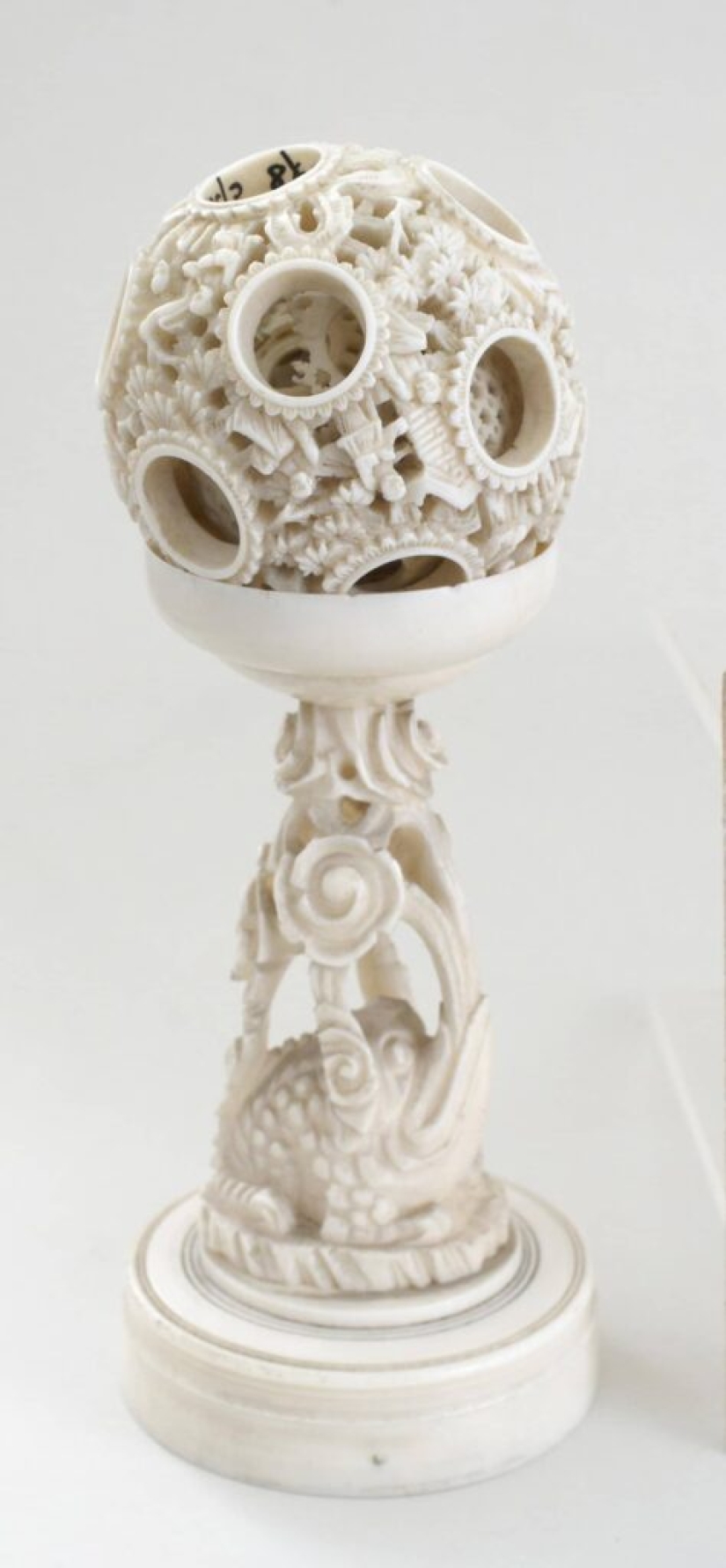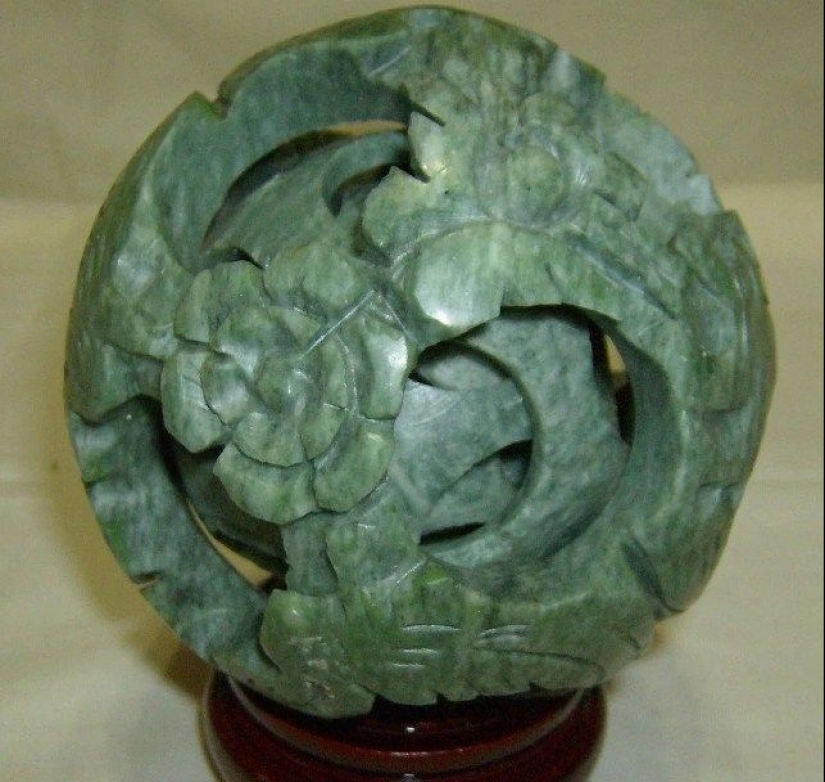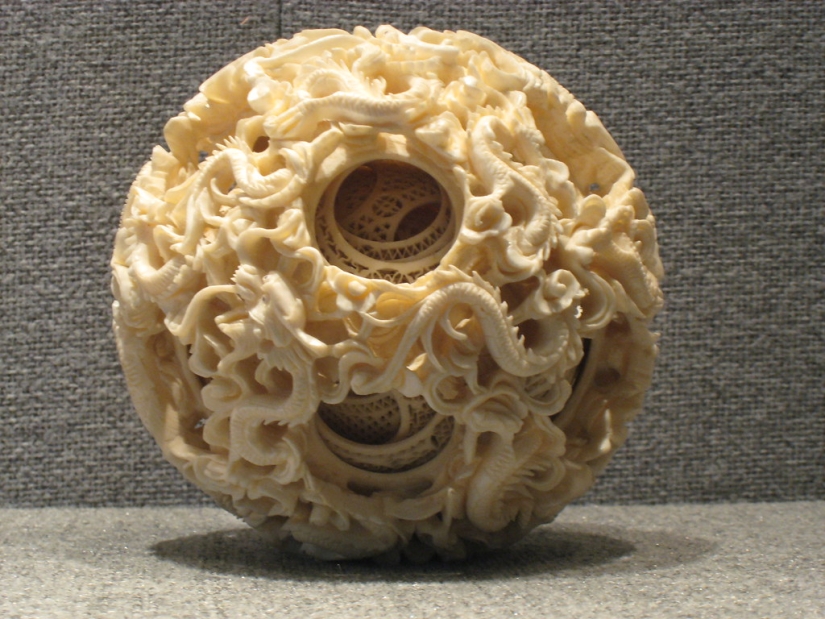The secret of making “devil balls”, masterpieces from ancient China
Categories: Asia | Culture | Technology
By Pictolic https://pictolic.com/article/the-secret-of-making-devil-balls-masterpieces-from-ancient-china.htmlThe ancient Chinese civilization gave the world many amazing creations. Many of them, such as the Great Wall or the Terracotta Army, amaze the imagination with their scale. But there are also less large-scale, but no less amazing masterpieces, for example, “devil's balls”.

These openwork items made of bone, stone or resin consist of many carved spheres nested one inside the other. They are not connected to each other and rotate freely. But the most amazing thing is that each of them is cut from a single piece of material, and the craftsmen did not use glue or other joining methods in their manufacture.
It is not known exactly when the first carved balls appeared, but scientists believe that this art is at least 1000 years old. Most "devil balls" are made from ivory - the tusks of elephants, both modern and fossil. This is an ideal material for carving. It is quite hard, has a beautiful color, can be easily processed and polished. A thin layer of such bone also has some transparency.

But ivory has an unpleasant feature - it does not forgive mistakes when processed. One wrong movement of the cutter, and the workpiece is damaged, and the work must be started over. Therefore, skilled bone carvers were highly valued both in ancient times and in our days.

But let’s return to those “devil’s balls”. Why did the creations of human hands, made with attention and love, receive such an eerie name? The thing is that people did not believe that such balls could be created by a person, and attributed their production to evil spirits.

There were also legends in China that masters who learned the secret art were kept locked up and even killed so that they could not teach the technique to others. It is likely that this is just one of the myths that have arisen over the centuries around “devil’s balls”. There was no point in killing the carver, since the nuances of such skill can only be comprehended by a few endowed not only with talent, but also with excellent coordination, sharp vision and a steady hand.
The skill of creating openwork bone balls developed rapidly in the 3rd-10th centuries AD. The peak of popularity of this art form occurred during the Ming Dynasty. At this time, ivory and stone carvings were in particular demand. Not only masterpieces pleasing to the eye were produced, but also quite practical things. Carvers created boxes, smoking pipes, bottles for incense and medicine, and much more.

During the Ming Dynasty, two main schools of carvers were formed: Beijing and Canton (Guangzhou). They used different techniques and had different styles of work. The Beijing school is characterized by laconic forms and the use of colors for decoration. The masters of the Cantonese school gravitated towards complex, even filigree carving.

The first balls created using bronze cutters were not very impressive. Truly amazing creations appeared when precision steel instruments arrived in China from Europe. The craftsmen quickly mastered their manufacture and began to create balls with surprisingly thin through threads.

For a long time, the two schools competed with each other, but in the end the palm went to masters from Canton, or more precisely, from the city of Guangzhou. This modern metropolis remains to this day a place where the secrets of ancient craftsmanship are carefully kept. There are very few carvers creating works of art. They carefully select students to pass on their secrets and continue the tradition.
When you see the “devil’s ball,” everyone has a question: how can this be done without the use of modern technologies. The question is quite logical, because the simplest objects consist of three nested balls, and the most complex ones consist of several dozen. The most amazing creation was presented in 1977 by master Wen Rongbiao. He broke his father's record of 25 balls and cut out a sphere with 42 attachments!

All the balls, located one inside the other, are openwork. The outer one has a diameter of 15 cm, and the inner one is comparable in size to the thickness of paper! The balls rotate independently of each other, and each of them has a unique carving that is not repeated anywhere. This record has not yet been broken, but no one believed that it was possible to cut out 25 balls. So, new winners in this race will certainly appear.
Yes, not everyone can cut out “devil’s balls”. But today everyone can learn the basics of this art. At the beginning of the work, the carver selects a suitable bone fragment, homogeneous and without cracks. From it he forms a perfect smooth ball. Several cone-shaped holes are cut into it, the imaginary axes of which converge exactly in the center of the workpiece.

Then follows the crucial stage of marking. The craftsman makes marks in each hole, determining the number of embedded elements. Work begins with the inner ball, which is cut out from the inside. Then they create the next ones one by one, moving towards the surface. The main tool for this is a thin L-shaped cutter, which is inserted inside through the holes.

Each finished ball is carefully separated from the others, cutting off the remaining bridges. The result is a one-piece “matryoshka” made from freely rotating balls with holes. Only after this the carver begins to apply patterns to their surface. At the same time, it constantly moves the elements inside, relative to each other.

The top sphere is always slightly thicker than the others. This is the face of the product and its master decorates it especially carefully. Small diameter holes do not allow the cutter to see the entire working area. Therefore, the master relies on instinct, experience, sharpness of the cutter and firmness of the hand. The slightest mistake and the work is irrevocably ruined. Considering that it can take more than a year to create one ball, you can imagine the responsibility of each movement.

Another wonderful category of human creations are bottle sailboats. Even if their creation does not require as much time and labor as Chinese carved balls, they still surprise and delight.
Recent articles

Sometimes you see a tattoo on a person and think: "Why did he do it at all?". A familiar feeling? If you have never experienced it, ...

Taxi ride like a lottery — you never know if you will pull the winning ticket. Even the official services like Uber does not ...

Finnish photographer Juha Tanhua has shot an unusual series of "space photos". Astrophotographic images of stars, galaxies and ...